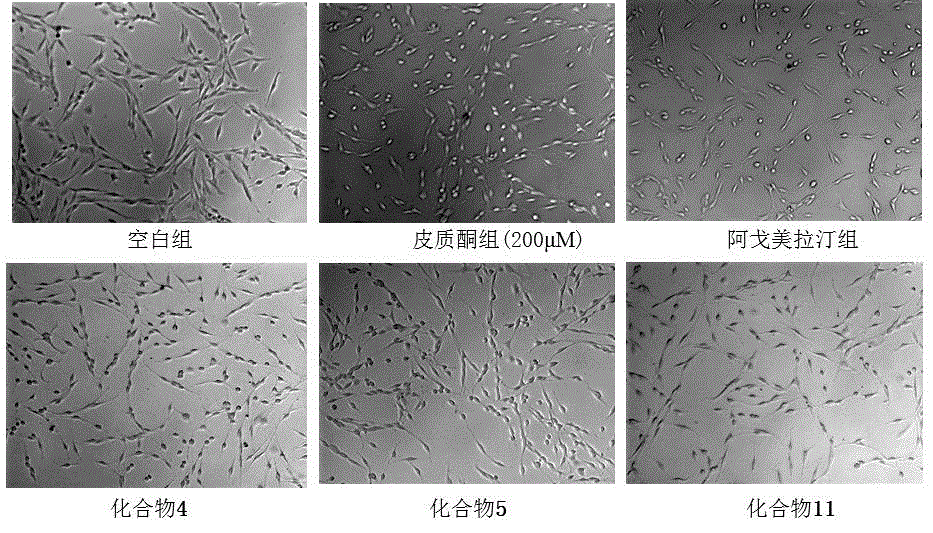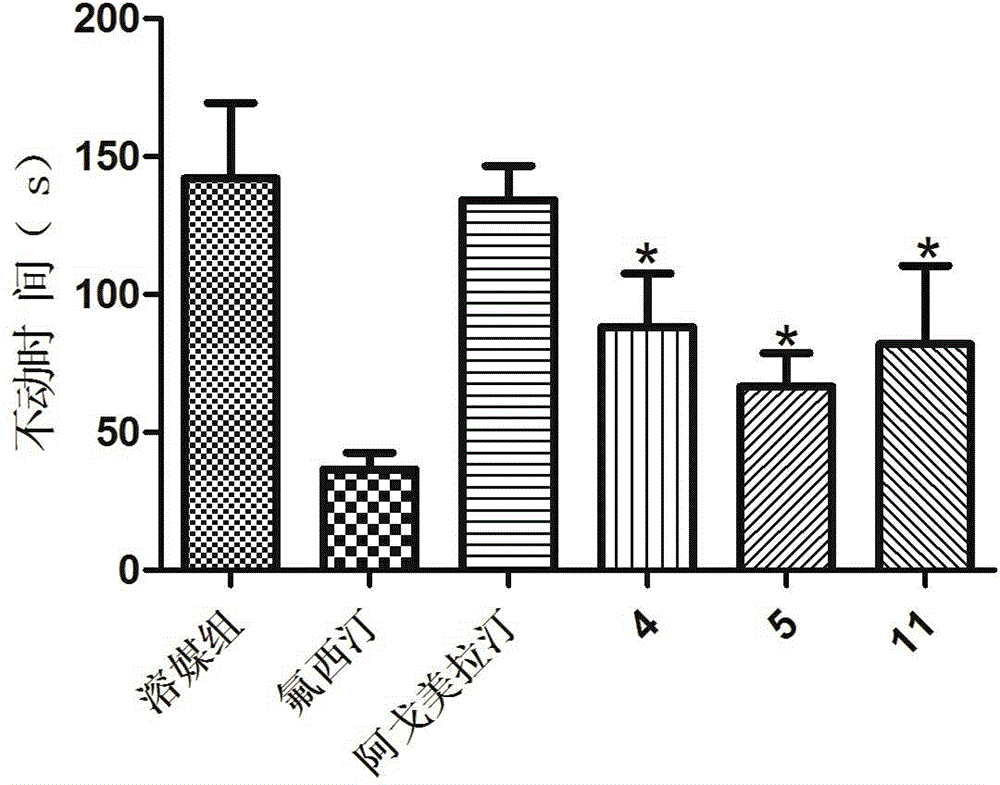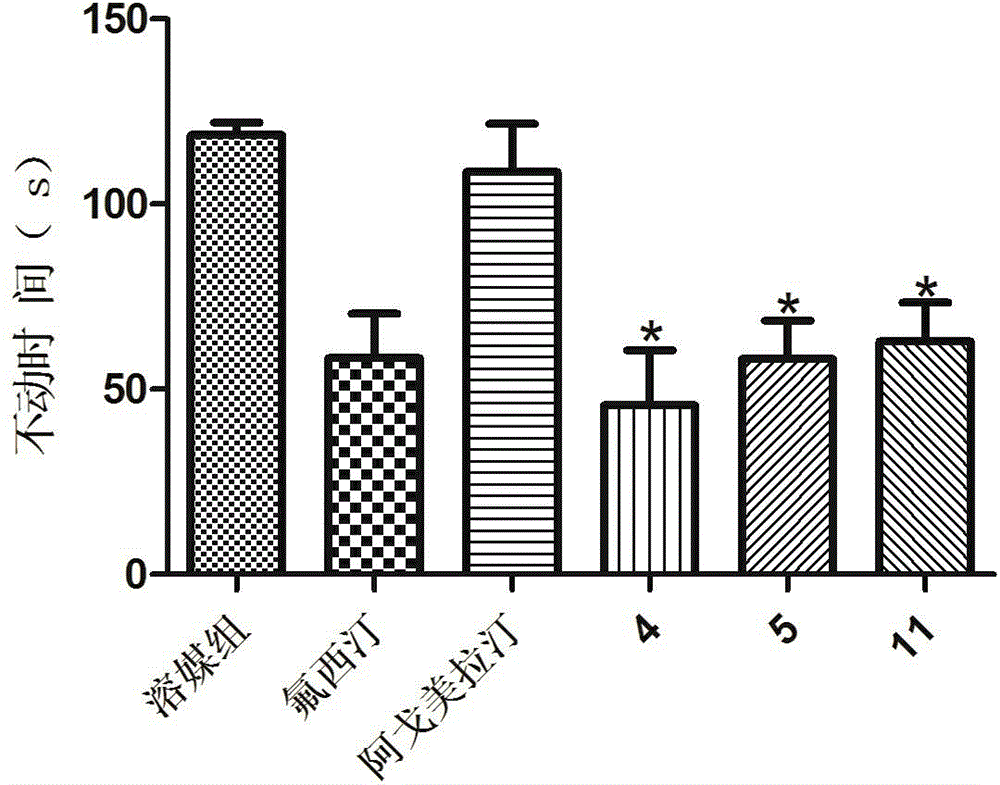Dihydro isoquinoline compound and application thereof in preparation of nerve protection or antidepressant medicament
A dihydroisoquinoline and compound technology, applied in the field of medicine, can solve the problems of poor patient compliance and no expected treatment response, and achieve good acute and chronic treatment of depression, good clinical application prospects, and obvious neuroprotection and repair The effect of the function
- Summary
- Abstract
- Description
- Claims
- Application Information
AI Technical Summary
Problems solved by technology
Method used
Image
Examples
Embodiment 1
[0029] Example 1 Preparation of 2-(2-(7-methoxy-3,4-dihydroisoquinolin-1-yl)ethyl)isoindole-1,3-dione (2)
[0030]
[0031] Weigh 3-(1,3-dioxoisoquinolin-2-yl)- N -(4-Methoxyphenethyl)propylamine (1) 70 g (0.20 mol) in a 2L reaction flask, followed by adding P 2 o 5 36g (0.25mol), xylene 400mL and POCl 3 110 mL (1.2 mol), heated to 125 o C, stop the reaction after 3 hours, pour off the xylene, adjust the pH to 10 with hydrochloric acid, extract with DCM (500 mL×3), evaporate the solvent, separate by column chromatography, and elute with DCM / MeOH=100:1, Obtained 33.5 g of yellow solid 2-(2-(7-methoxy-3,4-dihydroisoquinolin-1-yl)ethyl)isoindole-1,3-dione (2), yield : 50.8%. 1 H-NMR (DMSO- d 6 ): 7.86-7.81 (m, 4H), 7.15-7.10 (m, 2H), 6.94-6.91 (m, 1H), 3.87 (t, J = 8 Hz, 2H), 3.76 (s, 3H), 3.48 (t, J = 8 Hz, 2H), 3.01 (t, J = 8 Hz, 2H), 2.52 (t, J = 8Hz, 2H); 13 C-NMR (DMSO- d 6 ): δ 167.72, 163.61, 158.12, 134.27, 131.61, 129.13, 128.97, 128.29, 122.87, 1...
Embodiment 2
[0032] Example 2 Preparation of 2-(7-methoxy-3,4-dihydroisoquinolin-1-yl)ethylamine hydrochloride (3)
[0033]
[0034] Weigh 33.5 g (100.2 mmol) of 2-(2-(7-methoxy-3,4-dihydroisoquinolin-1-yl)ethyl)isoindole-1,3-dione (2) In a round-bottomed flask, add 500 mL of concentrated hydrochloric acid, heat to reflux, and after 8 h, spot the plate to complete the reaction, stop the reaction, evaporate the solvent, add an appropriate amount of acetone, immediately a solid precipitates, and filter with suction to obtain a gray solid 2-( 7-methoxy-3,4-dihydroisoquinolin-1-yl)ethylamine hydrochloride (3) 20.9 g, yield: 86.7%. 1 H-NMR (DMSO- d 6 ): 7.58 (s, 1H), 7.45-7.37 (m, 2H), 3.89 (s, 3H), 3.80 (t, J = 8 Hz, 2H), 3.61 (t, J = 8 Hz, 2H), 3.46 (br, s, 2H), 3.23-3.22 (m, 2H), 3.03 (t, J = 8 Hz, 2H).
Embodiment 3
[0035] Example 3 N Preparation of -(2-(7-methoxy-3,4-dihydroisoquinolin-1-yl)acetamide oxalate (4)
[0036]
[0037] Weigh 20.9 g (75.4 mmol) of 2-(7-methoxy-3,4-dihydroisoquinolin-1-yl) ethylamine hydrochloride (3) into the reaction flask, and then add potassium carbonate 22.9 g (165.88 mmol), DMF 120 mL, and finally add 7.8 mL (82.94 mmol) of acetic anhydride dropwise under ice bath, naturally warm to room temperature, stop the reaction for 10 h, add 200 mL of water and 300 mL of DCM, separate the liquid, evaporate the solvent , to obtain a brown oil, separated by column chromatography, and eluted with DCM / MeOH=80:1 to obtain a light yellow oil. After dissolving an appropriate amount of acetone, acetone solution of oxalic acid was added dropwise thereto, and a large amount of white solids were precipitated immediately. Filtered, 8.5 g of white powdery solid can be obtained, yield: 39.9%. 1 H-NMR (D 2 O): 7.34-7.30 (m, 2H), 7.27-7.24 (m, 1H), 3.78 (s, 3H), 3.73 (t, J ...
PUM
 Login to View More
Login to View More Abstract
Description
Claims
Application Information
 Login to View More
Login to View More - R&D
- Intellectual Property
- Life Sciences
- Materials
- Tech Scout
- Unparalleled Data Quality
- Higher Quality Content
- 60% Fewer Hallucinations
Browse by: Latest US Patents, China's latest patents, Technical Efficacy Thesaurus, Application Domain, Technology Topic, Popular Technical Reports.
© 2025 PatSnap. All rights reserved.Legal|Privacy policy|Modern Slavery Act Transparency Statement|Sitemap|About US| Contact US: help@patsnap.com



